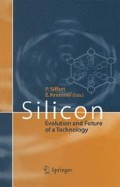Abstract
For the construction of high-power devices such as the high-power thyristors that are commonly used for the control of motor drives for engines and rolling mills and for high-power DC transmissions, large-sized silicon crystals having an extremely tight phosphorus background doping corresponding to about 40 Ω cm or higher are required. The exact level of the phosphorus concentration and its homogeneous distribution are decisively responsible for the electrical quality of the thyristor: the breakdown behaviour and blocking voltage depend upon the maximum of the doping concentration, while the minimum of the doping concentration is responsible for the quality of the hightemperature behaviour of the device. Optimal properties can be expected if the distribution of the dopant is exactly homogeneous and no difference between the maximum and the minimum of the dopant concentration exists.
Access this chapter
Tax calculation will be finalised at checkout
Purchases are for personal use only
Preview
Unable to display preview. Download preview PDF.
References
J. Burtscher: Resistivity fluctuations, growth striations and swirls in silicon single crystals. Proceedings of the European Summer School, July 8–12, 1974, Bad Boll, ed. by H. Weiss (1974) pp. 63–91
E. Spenke, W. Heywang: Phys. Stat. Sol. (a) 64 (11), 12 (1981)
M. Schnöller, E. Spenke: Physik in unserer Zeit 7 (1), 1 (1976)
P. Voss: IEEE Trans. Electron. Devices ED-20, 299 (1973)
A.F. Witt, H.C. Gatos: J. Electrochem. Soc. 115, 70 (1968)
D.T.J. Hurrle, E. Jakeman, E.R. Pike: J. Cryst. Growth 3/4, 633 (1968)
K. Morizane, A.F. Witt, H.C. Gatos: J. Electrochem. Soc. 114, 738 (1976)
M. Schnöller: Nuclear transmutation doping. In: Landolt-Börnstein,New Series Vol. 17, Semiconductors,Subvolume c, ed. by M Schulz, H Weiss (Springer, Berlin, Heidelberg 1984) Sect. 6.1.4.3., pp. 185–191 and 513–516
K. Lark-Horovitz: Nucleon-bombarded semiconductors. In: Semiconducting Materials, Proceedings of a Conference at Univiversity of Reading ( Butterworth, London 1951 ) pp. 47–69
M. Tanenbaum, A.D. Mills: J.Electrochem. Soc. 108, 171 (1961)
E. Haas, J.A. Martin: Nuclear transmutation doping from the viewpoint of radioactivity. In: Neutron Transmutation Doping in Semiconductors, ed. by J.M. Meese ( Plenum Press, New York and London 1979 ) pp. 27–36
E.W. Haas, M.S. Schnöller: J. Electron. Mater. 5, 57–68 (1976)
P. Voss: private communication (1976)
J. Corish, F. Benière, V.K. Agrawal, S. Harridos, C. Defeux: J. Appl. Phys. 50, 6338 (1979)
C. Jagannath, Z.W. Grabowsky, A.K. Ramdas: Phys. Rev. B 23, 2082 (1981)
A. Yusa, D. Itoh, C. Kim, H. Kim, K. Hushimi, S. Ohkawa: Application of NTD silicon for radiation of surface barrier type. In: Neutron Transmutation-Doped Silicon. Proceedings of the Third International Conference on Neutron Tansmututation Doping of Silicon, Aug. 27–29, 1980, Copenhagen, ed. by J. Guldberg (Plenum Press, New York 1980 ) pp. 473–485
W.V. Ammon: Neutronen in der Silizium-Haibleitertechnik, Neue Forschungsneutronenquelle G arching ( Technische Universität München, Garching 1998 ) pp. 78–80
J. Krauße: National Bureau of Standards Special Publication 400–10, Spreading Resistance Symposium, Proceedings of a Symposium held at NBS, Gaithersburg, MD, June 13–14 (1974)
J.C. Irvin: Bell Syst. Tech. J. 41, 387 (1962)
M. Schnöller: IEEE Trans. Electron Devices 21, 313 (1973)
Editor information
Editors and Affiliations
Rights and permissions
Copyright information
© 2004 Springer-Verlag Berlin Heidelberg
About this chapter
Cite this chapter
Schnöller, M. (2004). Neutron Transmutation Doping (NTD) of Silicon. In: Siffert, P., Krimmel, E.F. (eds) Silicon. Springer, Berlin, Heidelberg. https://doi.org/10.1007/978-3-662-09897-4_12
Download citation
DOI: https://doi.org/10.1007/978-3-662-09897-4_12
Publisher Name: Springer, Berlin, Heidelberg
Print ISBN: 978-3-642-07356-4
Online ISBN: 978-3-662-09897-4
eBook Packages: Springer Book Archive

